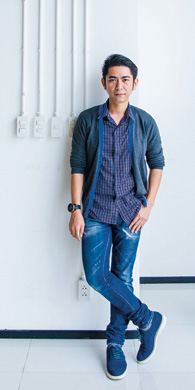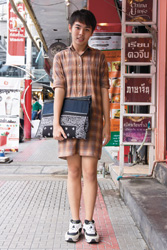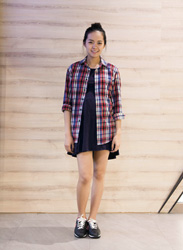Interview: Wong Chen-Hsi
The director of Innocents talks to us about the significance of her debut feature.
How did the film come about?
I’ve always been very interested in outsiders, people on the edge of society who are looking in from the periphery. It was very important to me to shoot the film in Singapore rather than find an equivalent location in Malaysia. The film is very much about memory, and capturing a part of Singapore I knew we would soon lose. Every single location that we shot in was demolished or torn down soon after.
What problems did you have putting the film together?
The entire film, including post, was made for around $150,000 and we only had 18 shooting days. A lot of people worked on the film pro bono simply because they believed in it, and that allowed us to achieve a wonderful intimacy on set that is reflected in the final film. But our post took over a year, because people were donating time in between their other jobs and could only work on the film during odd periods. We could barely afford any lights so we had to utilize the directionality and intensity of natural sun for our classroom scenes, giving us very limited shooting periods. For both the interiors and exteriors, we were always rushing to catch the light. In fact, we were also always rushing to catch the rain. It seems that it’s a rule of thumb that it rains when you need it to be sunny, and that it’s sunny when you need it to rain!
How do you think the film will fare in the canon of contemporary local cinema?
I do hope it can still find cultural permanence and that people will be willing to support small films like this. This is a film about loss, and I hope that we’ve managed to capture in some small way the heartbeat of our generation, and that Singaporeans can relate to Innocents in terms of pieces of half-forgotten memories, objects from childhood that were left behind, or in terms of the many physical spaces of childhood that no longer exist.
Innocents is on through Sep 29, Oct 3-5, 19-20, various times at Screening Room @ The Arts House. $10 at the door.
Advertisement
More and more works like yours are moving into the galleries—what does this signify?
An increased level of appreciation, I guess. It’s good that the art form is going places not just remaining on the streets. It gives the artworks a higher chance of mortality. Although the issue about how “street art should remain in the streets” will surface, the move adds more value to both the art and the maker.
With public spaces here still out of bounds, is there a real street art scene here?
Of course there is. We honestly don’t care whether a space is out of bounds or not. We go out and do it regardless. It’s been around for years and only noticed by those who are attentive.
Tell us more about your latest work in the gallery.
I like my works to interact with spaces, be it indoors or outdoors. For this show, I was given a small section in the gallery to work with and see what I could come up with. I painted multiple layered stencil figures of myself exploring that space, as a replacement to tags where a graffiti artist usually paints his or her name.
Who are you influenced by?
My collective RSCLS has been a major influence in my art lately. They’re a bunch of unique individuals who are always challenging themselves in their work, and that drives me to push further with mine. I work primarily with spraypaint or any fast drying medium. I have very little patience.
Anthropos: Navigating Human Depth in Thai and Singapore Contemporary Art is on through Oct 13 at Sundaram Tagore Gallery.
Advertisement
You got your start really young. Has that helped you as an entrepreneur?
Yes, people don’t feel intimidated by me, plus I benefit from youthoriented events and schemes such as StartupMalaysia and free co-working space at SCAPE.
What are the biggest differences between Singapore and Silicon Valley?
People in Silicon Valley have a cando spirit. Singapore has not seen much big acquisition and people have no reason to take bigger risks. But with the recent Viki acquisition for $200 million, I believe that there are bigger things to come.
What are some of the most unique lessons offered on Learnemy?
A dating class by an expert coach from LunchActually, a cheerleading class from a competitive cheerleader with seven years of experience, and a clay-sculpting class by a miniature-food artist.
Where do you see Learnemy in the next 10 years?
I see it transforming education. Just imagine this: someone wants to learn to be a designer. He can schedule a web design class in the morning, logo design in the afternoon and a marketing class in the evening. There’s no need to take on a full bachelor’s degree at university. That’s the world I want to live in.
Advertisement
My parents loved Queen and David Bowie and my dad also loved country music. I’m pretty sure I can sing any Kenny Rogers song.
We definitely have a vibrant music scene in Singapore—with great singers such as Jack & Rai, Tanya Chua and Stephanie Sun. The indie music scene has really been thriving in recent years.
Our music is typically Singapore-centric and comes with a dose of local flavor. That gives us an edge to branch out bothregionally and globally.
My energy and inspiration comes from my family.
At work, we are all adults and as long as everything gets done, it’s all good.
As a kid, I always enjoyed school.
I met a group of girls in primary school and still remaining incredibly close to them 33 years on. In fact, we are just about to head to Italy for two weeks to celebrate the beginning of a new decade.
Everyone’s first job is the best. I started with Time Warner and got to work with many different industry icons, as well as travel pretty extensively.
I never knew what I wanted to be, not even when I started college. But once I got a taste of sales and marketing, I realized that was where my interests lay and never looked back.
Having started in print and moved to digital—and working in the region for 17 years—I have seen how each country adapted to this new world at different paces.
I am an immigrant in this new world and it never ceases to amaze me how technology is changing the way we do things.
I had a mentor who was 16 years old. The move from print to digital proved to be more challenging than I thought it would be. But I was determined to learn, so I just focused and did what I had to do to.
Remember your first Walkman? Back then, I would have never thought I could stream 20 million songs through my smartphone.
Go and do the things that scare you most. It is the best confidence builder and you will be surprised by how it actually helps put everything into perspective.
I can stand in front of 800 people and actually enjoy myself. Public speaking used to make me so incredibly nervous, but I made sure I put up my hand at work and got a chance to do it.
Wallflower would struggle at Spotify. We love people who want to push boundaries and we are also an office that heavily subscribes to the “work hard, play hard” philosophy.
Education never stops.
Advertisement
What’s the most underrated travel destination?
Montenegro. I’ve heard a lot about it from friends who have been or live there but it’s rare that you read about it especially in our part of the world. It’s steeped in culture and history, dotted with medieval ports that are on the UNESCO World Heritage List and really is off the beaten track. Its best kept secret? These amazing restaurants that you can only get to by boat: Forte Rose, Dobrec, Pantagana, Stari Mlini and Vino Santo.
What are some of your best travel tips?
With modern technology comes easy access to some really cool inside intel. Download apps that will come in handy like street directories, emergency numbers, that great sidewalk café or that great bar where, they serve those amazing cocktails, or that bookstore tucked away at the end of that street. I bookmark everything. I also never leave home without my passport holder. It stores multiple mobile sim cards and if you travel as frequently as I do, you definitely want to keep them safe.
What’s the next big trend in travel?
There so many these days, eco travel, medical travel, adventure travel, digital detox, design hotels, boutique hotels, pet friendly hotels, safaris, ski lodges, ashrams...The next trend? I’d like to think train travel. It’s perhaps one of the world’s oldest modes of travel. But it never really caught on as a trend for our generation. It seems to be like a forgotten element in the romance of travel. I do hope we get to see more of that in the future.
What’s your favourite destination and why?
Italy. It has been my dream destination and I can’t shake the feeling it gives me just thinking about it. I keep dreaming of the day I get to stand on the terrace at the dreamy hotel the Le Sirenuse enjoying breathtaking view with a glass of Champagne. Bliss.
Angeline Leo is the director at The Magnolia Creative Collaborations.
Advertisement
How did you get into baking?
I always had a sweet tooth. I’m the type of person who will look at the dessert menu before going to a restaurant to plan my desserts first. But despite my love for desserts, I only started baking later in life. Baking was my way of de-stressing after a long day, and getting to savor the fruits of my labor was a bonus.
What kinds of cakes do you most enjoy baking?
Different types of cakes bring different challenges and also satisfaction, which I relish. For mousse cakes, the challenge would be to pair different flavors and textures. For cupcakes, how do we make them moist, light and flavorful? For customized cakes, how do we turn our customers dreams into reality and at the same time not sacrifice taste?
Which is your favorite cupcake that you make?
Personally, my favorite would be the lemon raspberry cupcake as I like citrus fruit. It comprises lemon Italian meringue buttercream, a homemade raspberry jam core and vanilla buttermilk cake, sprinkled with raspberry croquelin.
What are the advantages of starting as a home baker?
Honestly, the only advantage of being a home baker is the lower operation cost—no rental to pay. Given the NEA regulation that doesn’t allow the sale of baked goods from home, we only made cakes for friends of friends—as a favor—rather than a commercial sale.
Who were your first taste testers?
My family members, and friends: My kids especially, as they give the most honest feedback.
What did you do before going into baking?
I was in the market research industry—both client and vendor. Prior to setting up The Audacious Cakery, I was a regional director for a market research vendor.
How did you know it was time to start a brick and mortar shop?
This is an open-ended question. Do you generate enough of a customer base before opening a shop (assuming you would have sufficient funding) or do you find an ideal shop location and start build your customer base?
What advice do you have for aspiring bakers?
You should have passion. Choose a job you love, and you will never have to work a day in your life. Do what you do with passion because it shows in your work.
How important are professional baking courses?
Personally, I think it would benefit aspiring bakers to attend some form of professional baking course. It provides a foundation in baking. The risk is much higher if one is self-taught and starts a business.
What are the most important things you've learnt in the process of starting up your own bakery?
Expect to work harder than you did ever before, things will go wrong and you are not superhuman—you will need help from your family and friends.
Sharryl Ng bakes at Audacious Cakery.
Advertisement
You make people laugh. So personally, what tickles your funny bone?
I love all sorts of different stuff: Laurel and Hardy, Tony Hancock, Pete and Dud, Fawlty Towers, Steve Martin, Billy Connolly, Larry David, Alan Partridge…
Is humor serious business?
Yes, but if you have decided you’ll do anything to make the joke work you can find yourself naked on stage or on TV pretty quickly—in this case you can't take yourself too seriously.
Standup comedy can really be a hit or miss thing. What sort of challenges did you face during the initial stages?
I'd like to think by now I don’t miss any more. When you first start out you die a few horrible deaths on stage, but you chalk them up to experience and keep trying. It certainly helps you make up your mind about whether you really want to do it.
What goes on in your head when you’re making the same joke for the umpteenth time and the audience watches you and laughs?
[Chuckles] I think what a great joke that must be, well done me.
What's tough about going on tour?
It’s a fractured lifestyle, and unlike everyone else you don’t think of weekends as anything special in particular. But I’ve been doing it so long I find sitting at home without a journey to make or a case to pack pretty odd.
Best thing about British humor?
I don’t know, because I don’t know my way around enough other kinds of humor to make a sensible comparison! We like to say we like laughing at ourselves, so I guess it might be that.
Is it stressful from everyday life coming from people who expect you to be a joker?
Not really. Because I play a character it tends not to be an issue.
What sort of preparations do you make before you go on stage? Do you have to “get into character”?
Not any more. I like some quiet time when I’m left alone to read or generally chill out.
From a scale of 1-10, how funny do you think you are?
A stone cold 10.
Your ultimate guilty pleasure?
I’m a huge fan of really good single malt whisky, but it’s too expensive to justify buying often. And when you have it, it seems too expensive to drink.
Al Murray The Pub Landlord: THE ONLY WAY IS EPIC tour takes place on September 27 at the Kallang Theatre, 8pm. $58-$108 from SISTIC.
Advertisement
How did you narrow down the 20 works from the museum's permanant collection?
The idea is to curate a collector’s cabinet of sorts. Unlike most museums today where curators work with fixed classifications (and hence the exhibitions become too academic), we wanted to evoke a more intimate and spiritual feeling with the space, as if you are visiting the home of a private collector.
What about the placements of the artworks within the gallery space?
It is important that we create some sort of communication between the paintings. For example, I’ve placed a work by Andy Warhol depicting Marilyn Monroe from 1967 with a piece by Hendrick ter Brugghen depicting a singing lute player from 1624. Both works are about entertainers from different eras and I’d like them to speak to one another. And to convey the vast sense of time and space and how it traverses, I’ve placed a work by Max Ernst depicting a city circa 1936-1939 between two portraits—one by Antony Van Dyck from the 1600’s and the other Jacopo Robusti dit Le Tintoret from the 1500’s.
Tell us more about the overarching theme of the exhibition then, which is “Transversality”.
“Transversality” is a term that goes some way towards explaining how small, timeless, community of artists, from all periods, from all cultures and origins, are united by a similar way of thinking, of reflecting, and of behaving. By its encyclopedic approach, every museum tends to make us forget its main role: to ensure that the works stay alive. They all speak of beauty, have identical references, and the same historical narrative. But these works have to be placed together in order to set up a dialogue – beyond borders and periods – for they summon up what we all have in common.
The second part of the exhibition is more spiritual in nature…
Yes, there are works by 20th century masters like Mark Rothko and Chu the-Chun shown alongside the Botticelli’s work of the depiction of Christ. There is a feeling of deep spirituality in these works and they are very much in touch with God. For Rothko’s works, for example, you could even sense the inspiration of light seeping through the painting.
Advertisement

 |
 |
|
It, 19, fashion student
Jumpsuit: Playhound
Clutch: JJ Market
Shoes: Chane
|
Siri Sirisubjanan, 23, freelance
Top: Uniqlo
Dress: H&M
Shoes: Nike
|
"Compared to the street fashion of my generation, where everybody wore Thai designer brands, the trend is shifting towards the high-street."
Advertisement

 |
 |
|
Boripat Singkaew, 23, graphic designer and illustrator
Hat: Siam
Top: Uniquo
Bottoms: Muji
Bag: Siam
Shoes: Converse
|
Nadda Kank, 32, advertising freelance
Top: Zara
Skirt: Siam Street shops
Sandals: Siam Street shops
Hat: Jatujak Market
|
"Young Thai people tend to follow celebrities. I think it would be more fun for people to explore new styles from those who really embrace different tastes."
Advertisement